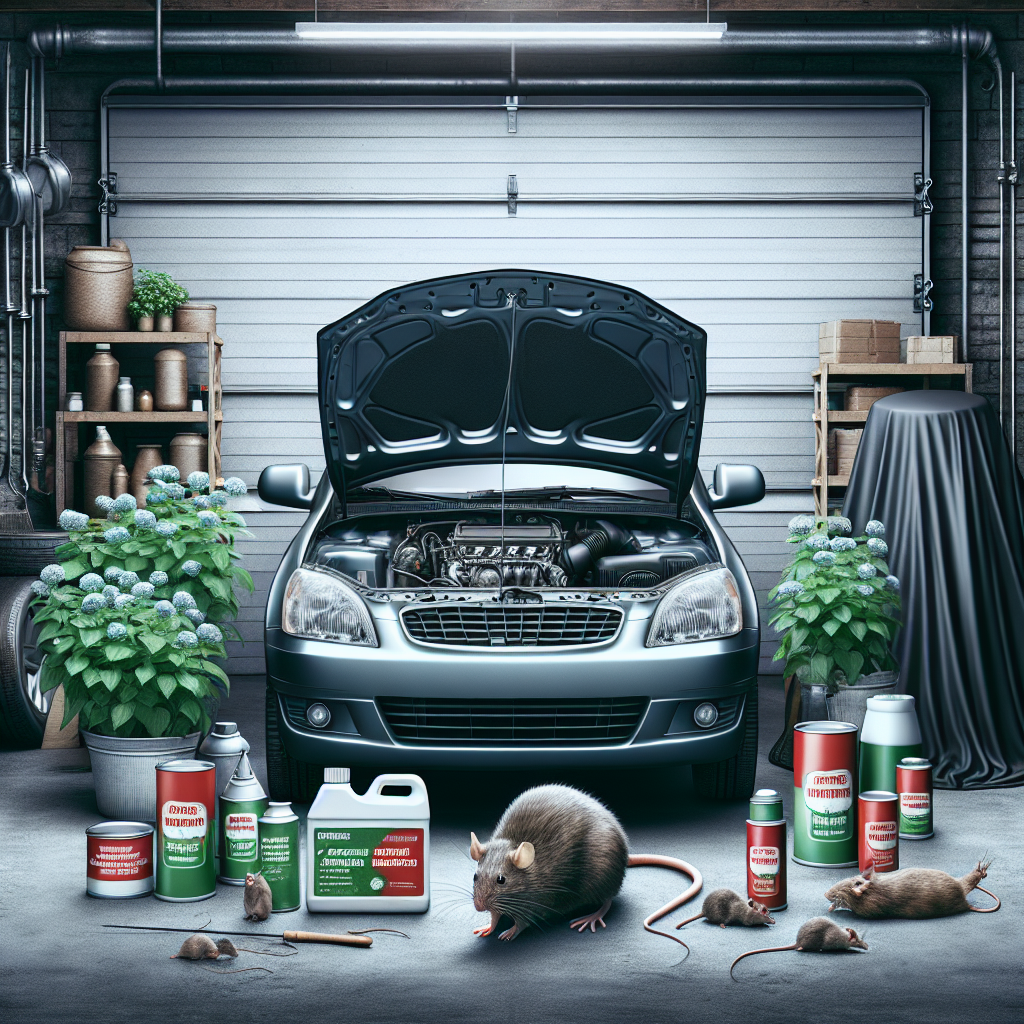How to Keep Bats Out of Attics and Barns
Published April 5, 2024 at 4:02 am
Discover practical strategies to safeguard your attic and barn from unwanted bat guests, ensuring a peaceful coexistence without the hassles of infestation.

Understanding Bat Behavior and Attraction Factors
Bats are complex creatures that play a critical role in our ecosystem, often acting as pollinators and natural pest control agents. However, when these nocturnal flyers take up residence in attics and barns, they can create serious issues for homeowners and farmers alike. Recognizing why bats are drawn to these structures is the first step in managing bat problems effectively.
One main reason bats are attracted to buildings is for shelter. Attics and barns often provide the perfect environment – dark, undisturbed, and enclosed spaces that mimic their natural roosting habitats. These areas are ideal for protecting bats from predators and for rearing their young during the maternity season. Moreover, your home might be inadvertently offering easy access through broken tiles, unscreened vents, gaps in siding, or other small openings that bats can exploit.
Pre-emptive Measures for Bat Prevention
Preventing bat infestations starts with making your property uninviting to these winged mammals. Begin by conducting thorough inspections to identify and seal up potential entry points. Remember, bats can squeeze through openings as small as a quarter of an inch! Common preventive measures include installing bat-proof screening on vents, repairing damaged roofing, and ensuring that windows and doors are tightly sealed.
Another strategy is to illuminate typically dark areas where bats might roost. Bats prefer the dark, so good lighting can be a deterrent. However, always be environmentally conscious with light placement to avoid disturbing surrounding wildlife or neighbors.
Humane Bat Exclusion Techniques
If bats have already settled in your structure, humane exclusion is the key. The aim here is to allow bats to leave but prevent them from re-entering. Installing one-way exclusion devices over entry points achieves this aim. These devices are designed in such a way that bats can exit through them but cannot return.
It’s important to note that timing is critical with exclusion practices. Avoid any exclusion during the maternity season, which typically runs from May through August, as it can result in babies being trapped inside and dying. Check with your local wildlife authorities for specific guidance as timing can differ regionally.
Understanding the intricacies of bat exclusion can be complex, and sometimes it might be in your best interest to engage a professional. Wildlife control companies like Terminix and Orkin specialize in humane bat removal, offering services that come with the assurance of experience and knowledge of local regulations. These companies conduct thorough inspections, seal entrances, and install exclusion devices, ensuring that the bats are not harmed and that you can reclaim your space safely.
Find This and More on Amazon
Attracting Bats to Alternatives: Bat Houses
Diverting bats from your property to a more suitable living environment can be a win-win situation. Bat houses are a fantastic way to provide an alternative habitat. Placed in an appropriate location, a bat house can mimic the eaves and rafters of an attic, tempting bats away from your home and toward a dedicated space in your yard.
The success of a bat house largely depends on its design, placement, and the local bat population. The Bat Conservation International website offers guidelines for choosing or building the right bat house, and their recommendations have become the gold standard. Generally, the house should be mounted at least 15 feet high, face the warm morning sun to maintain a warm temperature, and be located near a water source.
Reviews of pre-built bat houses often emphasize the importance of sturdiness and craftsmanship. The Big Bat Box is a highly praised product according to online reviews, featuring a single-chamber design perfect for smaller bat colonies. Users suggest that, when properly installed and placed, these boxes can become an effective new home for your nocturnal neighbors.
Find This and More on Amazon
Post-Exclusion Cleanup and Safety Measures
After successful bat exclusion, cleaning up the remnants of their stay is essential for health and sanitation reasons. Bat droppings, also known as guano, can harbor fungi that cause diseases such as histoplasmosis. Therefore, it’s necessary to wear protective clothing, including gloves and respiratory masks, during the cleanup process.
For the cleaning, you’ll want to use products that not only sanitize but also neutralize the strong odors that can remain. One highly recommended product is Simple Green Outdoor Odor Eliminator, known for its non-toxic formula that’s safe for use around pets and wildlife. Reviews suggest that it effectively removes the ammonia-like smell that bat guano can produce, making it a favored choice among those who have had to perform such cleanups.
Find This and More on Amazon
Understanding Legal Protections for Bats
Bats are protected under various federal and state laws, and it’s crucial to understand these before taking any action. For example, the Endangered Species Act protects certain bat species, and thus their removal requires specific legal permits. Always consult with wildlife professionals or your state’s wildlife department before attempting any exclusion or removal on your own.
If you’re interested in learning more about these remarkable creatures, taking care of indoor plants like those from the philodendron family can be a great start. While different from bats, these indoor plants can also improve air quality and the overall ambiance of your living space – a serene environment and a plus for you and the local ecosystem!
Bat-Proofing Materials and Installation Techniques
When bats are determined to make your attic their home, it can be quite a challenge to bat-proof your household effectively. Sturdiness and proper installation of exclusion materials are paramount. Hardware cloth, chimney caps, and sealant products are commonly used to secure potential entry points.
One popular sealant product is the GREAT STUFF™ Pestblock, with reviews highlighting its expansive properties and ease of use for sealing gaps and cracks. This foam sealant is designed specifically to block pests and creates a barrier that is difficult for bats to penetrate.
Choosing the Right Bat-Proofing Products
When selecting products for bat-proofing, it’s not only about effectiveness but also durability and safety. For example, opting for non-toxic, environmentally friendly options will ensure that other wildlife is not harmed. Reviewers often prefer products that are humane and have a minimal impact on the ecosystem.
Materials like heavy-duty polyurethane netting or stainless steel mesh are praised for their resilience against the elements and gnawing wildlife. The brand Xcluder has been noted for its pest control fabrics that can be cut to size and fitted around entry points to deny access to bats.
Find This and More on Amazon
Long-Term Monitoring and Maintenance
Once you’ve taken steps to keep bats out, don’t let your guard down. Continual monitoring and maintenance of exclusion techniques are crucial. This includes checking for signs of wear and tear and ensuring that no new gaps or cracks have formed that could serve as entry points.
Moreover, staying informed about bat behavior and their seasonal patterns can help you anticipate and prevent future infestations. Learning about the natural predators of bats can also give you insight into ecological changes that might make your property more attractive to bats.
Engaging the Community in Bat Conservation
While protecting your property from unwanted bat guests, consider also engaging in local bat conservation efforts. Bats are beneficial animals that control pest populations and pollinate plants. You might help spread awareness about the importance of bats in your community or participate in local conservation programs.
For gardeners and enthusiasts interested in making their outdoors more bat-friendly, you might want to visit Creating a Pollinator-Friendly Vegetable Garden, a page filled with tips on attracting beneficial wildlife to your gardening space.
When to Call a Bat Removal Expert
Sometimes, despite all efforts, professional help may be required. If the bat problem persists or you’re unsure about how to handle the situation safely, a bat removal expert should be your next call. They possess the necessary skills, equipment, and legal knowledge to deal with bat infestations in a way that is safe for both the bats and the household.
Their services usually include a detailed plan that not only removes the bats but also prevents their return. These experts often tout humane methods that ensure the least stress and harm to the bats while addressing the homeowner’s concerns.
Drawing a Fine Line Between Attraction and Exclusion
At the heart of any bat prevention strategy lies the balance between making your home unattractive to bats while supporting their conservation. This requires a nuanced approach that respects the ecological significance of these creatures while safeguarding your living space from their intrusions.
By understanding the needs and habits of bats, you might be able to coexist with them without sharing your attic space. Strategies like installing a bat house offer a middle ground that provides bats with an alternative roosting spot and maintains their beneficial role in the ecosystem.
Cost-Effective DIY Solutions
While professional services can be highly effective, they also come with a price tag. If you’re looking for more budget-friendly solutions, consider DIY projects. Many online resources and guides can help you build exclusion devices or bat houses using simple materials and tools.
However, remember to prioritize humaneness and effectiveness. Inaccurate execution or the use of inappropriate materials can lead to failure or even harm the bats – which is neither legal nor ethical. Always do thorough research or consult with experts beforehand.
Responsible Use of Chemical Deterrents and Repellents
The use of chemical deterrents and repellents can be a contentious topic in bat prevention. While there are chemicals marketed as bat repellents, their effectiveness and impact on bats and the environment are often questioned. It’s suggested to use them with caution or to seek alternatives.
For those needing to consider repellents, products like Natural Armor Animal & Rodent Repellent Spray are known to be effective for some without harsh chemicals. Customer reviews often point out that their plant-based formula is a plus, though results can vary depending on the situation and species of bats.
Homeowners might also find useful insights in resources like Breathing Easy with Peace Lilies, which shares information on indoor air purification. Altough it’s a different context, understanding other aspects of home care can contribute to a well-rounded approach to maintaining your living space.
Reviewing and Reflecting on Bat Prevention Approaches
After implementing preventive measures, it’s helpful to review their effectiveness periodically. Reflect on what works and adapt strategies accordingly. Sometimes, a combination of solutions is needed to effectively deter bats in the long term.
Sharing your experiences can provide valuable feedback for others dealing with similar issues. Whether it’s a product review or a homemade bat house success story, your input can be beneficial to the community. It can help refine strategies for both bat prevention and preservation.
Creating a Bat-Friendly Environment Outside the Home
Building a bat-friendly environment in your yard can be a wonderful way to support these creatures while keeping them at a safe distance from your house. Planting night-blooming flowers, maintaining water features, and reducing outdoor lighting can attract bats to your garden, helping with insect control.
Understanding the needs and preferences of bats, using the right products, and staying informed about best practices are all part of successfully preventing bats from settling in unwanted areas like attics and barns. From inspection to installation, everything must be done thoughtfully and responsibly.
For readers with a green thumb looking to create a space that’s welcoming to all sorts of beneficial wildlife, the Harvesting Tips: Getting the Most from Your Vegetable Garden article could be a great place to broaden your knowledge on a thriving garden ecosystem.
Identifying Signs of Bat Activity in Buildings
Bats are relatively silent, but there are indicators of their presence that homeowners should watch for. Hearing scratching or squeaking sounds from walls or ceilings during dusk or dawn, finding guano beneath eaves or inside the attic, and noticing an ammonia-like smell are clear signs of bat activity in a building.
Visual identification is also key. Look for dark staining around entry points, which is caused by the natural oils in bat fur. Inspecting your attic for roosts during the day when bats are likely to be sleeping can also confirm their presence.
Professional Inspections and Consultations
It’s wise to bring in experts for an inspection if you suspect bats are roosting in your property. Professionals can provide a nuanced understanding of the situation and can identify species, which is especially important if protected bats are involved. Additionally, their insights on seasonal behaviors can guide more effective exclusion and prevention strategies.
Wildlife removal experts are trained not just in identification, but also in assessing structural vulnerabilities of a property. They can point out potential fail points that homeowners might miss, and suggest tailored solutions based on the specific architecture of a building.
Understanding Exclusion Material Durability and Cost
When investing in materials for bat-proofing, it’s important to consider the trade-off between cost and durability. While cheaper options may be tempting, they may not withstand the elements or wildlife over time, leading to repeated expenditures and hassle. On the other hand, high-quality materials might seem costly upfront, but their longevity and effectiveness could save money and effort in the long run.
Reviewing product longevity and warranties can be helpful. Many manufacturers provide guarantees on their exclusion materials, signaling confidence in their products. Assessing these aspects can provide peace of mind that your investment is protected.
Choosing the Right Time of Year for Bat Exclusion
Bats follow specific seasonal patterns, and these should guide your exclusion efforts. In many areas, late summer and early fall are ideal for bat-proofing activities. This time window is after the maternity season, hence baby bats are able to fly and won’t be trapped inside, but before most bats enter hibernation, or migrate to winter roosts.
However, it can vary based on your local climate and species. Some bats might hibernate in your structure, and others could use it as a migratory stopover. Timing your exclusion to match these patterns will ensure the process is both humane and effective.
Landscaping and External Factors Influencing Bats
Your property’s landscaping can also be a magnet for bats. They are attracted to abundant insect populations, which can flourish in certain plants or water features. Proper management of your yard, such as pond maintenance to reduce mosquito populations, and careful plant selection to not attract insects that feed bats can reduce the appeal of your property to these nocturnal creatures.
Maintaining a tidy yard by trimming tree branches that hang close to the house and keeping garbage lids tightly closed to discourage insect scavengers can also be deterrents. It’s all about balance: supporting bats in the ecosystem, yet not directly next to your living areas.
Empowering Yourself with Knowledge and Expertise
Lastly, empowering yourself with knowledge on bat prevention and exclusion is potentially the most effective tool you have. Utilize resources like the Bat Conservation International and your local wildlife agency for guidance. Understanding bats, their needs, and behaviors, will aid you in cohabitating peacefully without inviting them into your home.
There are also books and online courses on wildlife management that can deepen your understanding of these creatures. With the right knowledge, you can be proactive about bat proofing and contribute to their conservation outside your home.
Joining Forces with Neighbors for a Cohesive Approach
Facing a bat issue can be much easier when done with the support of your community. Strategizing with neighbors and local conservation groups can help to manage bats on a larger scale. This can lead to shared costs in professional services, greater access to knowledge, and a stronger voice when contacting authorities for assistance or permission for exclusions.
Often, bats will move from an excluded building to another nearby option. A community-wide plan can be more effective in ensuring the bats find appropriate alternative roosts such as bat houses, which benefits the whole neighborhood ecosystem.
Balancing Ethics with Effective Control
In our efforts to control bat populations within our properties, we must not lose sight of the ethical considerations. It’s vital to use methods that are humane and legal, and to remember the beneficial roles that bats play. These principles should guide every step from prevention to exclusion, and even in the selection of products and services.
By following this balanced approach, you can maintain a bat-free home without disregarding the essential part bats have in maintaining a healthy environment. After all, harmony with nature is not just about dissuasion but also about appreciation and coexistence.
Final Thoughts on Keeping Bats at Bay
Combating the challenge of bats in attics and barns requires a multifaceted approach. From understanding bat behavior, utilizing the correct exclusion techniques, to investing in preventative measures and ongoing maintenance, every step is crucial. Professional advice and community cooperation can further bolster your efforts, while ethical considerations should remain a cornerstone throughout the process.
Ultimately, it’s about creating a well-rounded strategy that protects both your property and the bat population. As you navigate the journey of keeping bats out, remember that each action taken is part of a larger ecological picture. Equip yourself with knowledge, and be ready to adjust as you learn what works best for your unique situation.
If you’re looking to dive deeper into nature’s intricacies while appreciating the role of bats from a distance, exploring the world of indoor plants can be both enriching and rewarding. Take a moment to learn about plants like the snake plant by visiting ‘Caring for Snake Plants’, which thrives in low light and could be the perfect addition to your bat-friendly but bat-free home.
Shop more on Amazon
Flowers & Plants Team
Flowers & Plants Team


